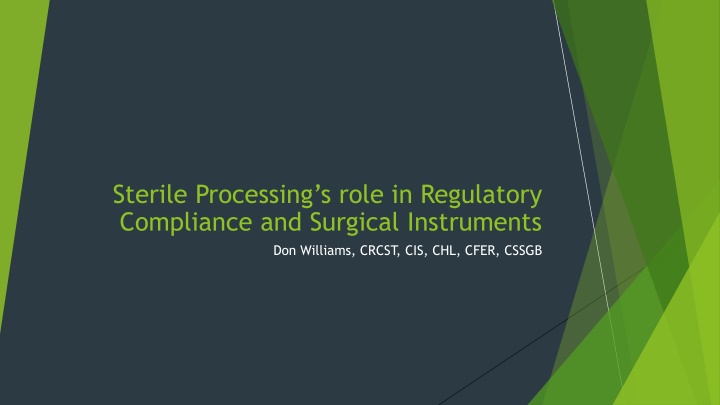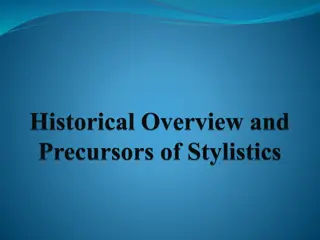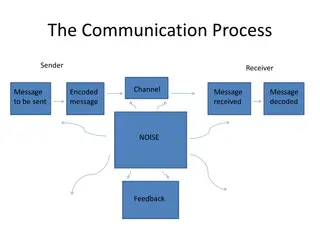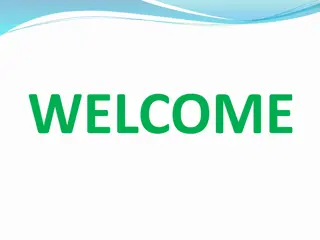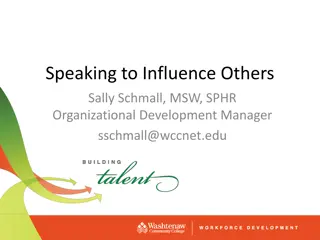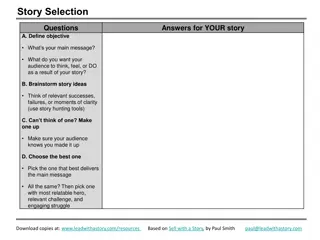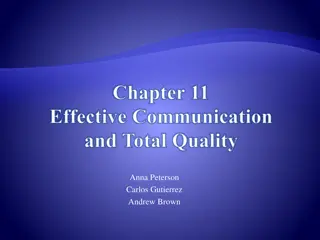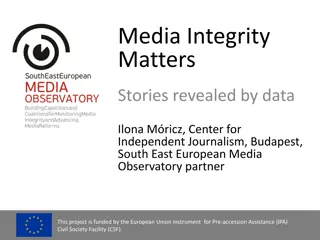Crafting Sticky Stories for Impactful Communication
Discover techniques for creating memorable stories that resonate with your audience. Learn how to make your message simple, unexpected, concrete, credible, and emotional. Find ways to avoid simplistic messaging and embrace complexity to engage readers effectively.
Download Presentation

Please find below an Image/Link to download the presentation.
The content on the website is provided AS IS for your information and personal use only. It may not be sold, licensed, or shared on other websites without obtaining consent from the author.If you encounter any issues during the download, it is possible that the publisher has removed the file from their server.
You are allowed to download the files provided on this website for personal or commercial use, subject to the condition that they are used lawfully. All files are the property of their respective owners.
The content on the website is provided AS IS for your information and personal use only. It may not be sold, licensed, or shared on other websites without obtaining consent from the author.
E N D
Presentation Transcript
Sterile Processings role in Regulatory Compliance and Surgical Instruments Don Williams, CRCST, CIS, CHL, CFER, CSSGB
Identify outbreaks associated with lapse in cleaning and disinfection practices Identify Evaluate the necessary training needed to maintain competency in SPD Evaluate Describe Describe decontamination and where it begins Objectives Review Review the implications of Immediate Use Steam Sterilization Understand Understand transportation of surgical instrumentation Understand the loaner process and how it affects daily operations Understand
Assessment of disease transmission Failures to follow recommendations for reprocessing of surgical instruments may place patients at risk for exposure to pathogenic microorganisms. When such failures occur, medical facilities often face considerable uncertainty and challenges in assessing the actual risks of disease transmission.
High Risk The following recommendations apply to devices and equipment contaminated with high-risk tissues (defined as brain [including dura mater], spinal cord, and eye tissue) from high-risk patients (i.e., those known or suspected to have CJD): 1) Devices that are constructed so that cleaning procedures result in effective tissue removal (e.g., surgical instruments) can be cleaned with a chemistry shown to safely reduce prion infectivity and then steam sterilized at 134 C (273 F) for greater than or equal to 18 minutes in a dynamic-air-removal sterilizer or at 121 C to 132 C (250 F to 270 F) for 1 hour in a gravity-displacement sterilizer. 2) Devices that are impossible or difficult to clean should be discarded. In some cases, the contaminated device may be placed in a container filled with a liquid (e.g., saline, water, or a cleaning solution known to safely reduce the risks of prion contamination) to prevent drying, then initially decontaminated by steam sterilizing it at 134 C (273 F) for 18 minutes in a dynamic-air-removal sterilizer (liquids must be removed before the device is sterilized) or at 121 C to 132 C (250 F to 270 F) for 1 hour in a gravity-displacement sterilizer or by soaking it in 1N NaOH for 1 hour. The device is then cleaned, wrapped, and terminally sterilized as described in 1).
The following recommendations apply to devices and equipment contaminated with low- risk tissues (e.g., defined as cerebrospinal fluid and kidney, liver, spleen, lung, and lymph node tissue) from high-risk patients. Devices can be cleaned and disinfected or sterilized using conventional protocols of high- level disinfection, thermal sterilization, or chemical sterilization. It is recommended that devices are cleaned with a chemistry shown to safely reduce prion infectivity. Steam sterilization or hydrogen peroxide gas sterilization processes shown to have safely reduced prion infectivity are preferred. Low risk Environmental surfaces contaminated with low- risk tissues require only standard disinfection using disinfectants recommended by OSHA for decontaminating blood-contaminated surfaces (preferably with 500 to 5,000 ppm sodium hypochlorite).
2 1 3 a) an initial orientation covering all tasks performed in the sterile processing area, including orientation in policies and procedures regarding infection prevention and control, safety, attire, personal hygiene, and compliance with state and federal regulations; b) continuing education at regular intervals to review and update knowledge and skills and to maintain competency and certification; and c) in-service training on all new instrumentation, devices, and equipment. Necessary Training needed to maintain competency
The Importance of Cleaning
Decontamination design considerations should include containment systems that must meet OSHA standards for contaminated items at the point of use. Importance of Cleaning The first steps in a proper reprocessing cycle are taken in the operation theatre. Coarse contamination, residues from hemostatics, skin disinfectants and slip agents, as well as caustic drugs should, wherever possible, be removed before the instruments are set down. During transport of instruments from the point of use to the decontamination area, appropriate precautions (e.g., use of a closed transport container) should be taken to avoid personnel exposure to blood-borne pathogens, contamination of the work environment, and further contamination of the instruments. The time between using instruments and cleaning them should be kept to a minimum.
Procedures must be developed, with support from the infection prevention and control and hazardous materials personnel, to protect personnel, patients, and the environment from contamination and to comply with OSHA regulations limiting occupational exposure to blood-borne pathogens (29 CFR Part 1910.1030) Transported to decontamination area as soon as possible after the completion of the procedure. The amount of time between use and decontamination should be minimized because the soil on items provides an ideal medium for microbial reproduction and increases the risk of corrosion. Biofilm can begin to form within minutes and is difficult to remove. In addition, soil can dry on the instrument if left standing, making it difficult to remove. Health care personnel should schedule the pickup and transport of soiled items from each area so that the items are transported and cleaned as soon as possible after becoming soiled. Instrument Transportation The procedures for packaging and transporting contaminated items off-site for processing must comply with applicable Department of Transportation (DOT) and state regulations.
Immediate Use Steam Sterilization Immediate Use Steam Sterilization (IUSS) may increase the risk of infection to patients. Time constraints may result in pressure on personnel to eliminate or modify one or more steps in the cleaning and sterilization process. Immediate use steam sterilization should be used only when there is insufficient time to process by the preferred wrapped or container method intended for terminal sterilization. Implants are foreign bodies and they increase the risk of SSI. If IUSS is unavoidable due to a documented emergency, a rapid-action biological monitoring device should be used along with a type 5 CI. The implant should be quarantined on the back table until the rapid-action indicator provides a negative result.
Sterilization Load configurations should ensure adequate air removal, penetration of steam into each package, and steam evacuation. Loading the sterilizer in this fashion allows adequate air elimination and drainage of condensate, which are needed to attain product sterility. Nonlinting, absorbent cart shelf liners can be helpful in drying a load. Nonlinting materials are recommended because lint can be introduced into a patient s wound and cause a foreign-body reaction. Placing metal items below textile items enables condensate to drain out without dripping onto items below.
Loaner Instruments
Factors that affect Sterilization WATER QUALITY Water quality supplied to each piece of equipment should meet the manufacturers' requirements. Water quality is key to prolonging the life of medical instrumentals, and more importantly, minimize the risk of patient infection resulting from contaminated medical devices. Water quality is a factor in all disinfection and sterilization processes. If the quality of the water used for steam generation for steam sterilization or hot-water disinfection is inappropriate, residues that condense out of the steam onto the device can lead to staining or corrosion of medical devices. Furthermore, the quality of water can affect the efficacy of LCSs or HLDs that are diluted to achieve the correct use-dilution. It should be noted that many sterilization methods do not completely inactivate endotoxins on a device. Therefore, Critical Water should be used to rinse critical devices before sterilization to help reduce the amount of endotoxins on the sterilized device and to lessen the chance of a pyrogenic or other adverse patient reaction.
Loaner Instruments Cont. Implementation of tracking and quality controls and procedures is necessary to manage instrumentation and implants that are brought in from outside organizations and companies. Loaner instrumentation checklist CSSD notified of loaners prior to receiving them Received in facility (decontamination) at least two working days (48 hours) for existing loaner sets and three working days (72 hours) for new sets before scheduled case Inventory list provided/available FDA-cleared manufacturer written instructions for cleaning, packaging, and sterilization available Inventory and quality checks completed Multiple trays numbered and labeled (patient name, surgeon) Trays do not exceed 25 pounds All instruments in good condition, with no rusting or pitting Container in good condition, with no rusting, tape, residue, etc.
Loaner Instruments Cont Communication. There s no such thing as too much communication concerning loaner trays. A smart CSD leader will constantly talk to all parties involved with these instruments, including OR leadership, physicians, vendors, CSD staff and infection preventionists. Especially important is ensuring that CS technicians have easy access to IFUs, in advance of needing to sterilize instruments. Furthermore, facilities should require that vendors provide detailed in- servicing, education and training on instruments before bringing them into service. Common issues with loaner instrumentation include an inability to follow manufacturers recommendation for cleaning and sterilization due to a lack of training, lack of sets and lack of time, which in turn increases immediate use sterilization. The high-level methodology for healthcare systems to avoid these issues is by adhering to the three Cs: Collaboration. CS leaders should work with all parties to ensure that every patient has access to the right instrumentation that has been properly decontaminated and placed through terminal sterilization. This ensures the same standard of care for every patient. Control. CS departments can exercise control through the diligent use of a well organized set of policies and procedure. This is arguably the single most important aspect of dealing appropriately with these trays, because it should hold all parties accountable.
Quality Control Monitoring and verifying the cleaning process Sterilization process monitoring monitoring of every package and sterilization load routine monitoring of sterilizer efficacy qualification testing of the sterilizer after installation, relocation, sterilizer malfunction, major repairs, and sterilization process failures periodic product quality assurance testing
Summary Infection Preventionist collaboration with the Sterile Processing Department (SPD) is key Include SPD in your Joint Commission tracer and rounding activities Ensure that all policies and procedures are evidence-based and up to date Quality does not automatically translate into patient safety Monitoring of the sterilization process is necessity for maintaining patient safety Conduct regular risk assessments of the various processes and potential problems using tools such as FMEA, Situational Analysis, and RCA when issues arise that impact patient safety Be aware of the concerns in the SPD
References ANSI/AAMI ST79: 2017 Comprehensive guide to steam sterilization and sterility assurance in health care facilities AORN Guidelines for Perioperative Practice 2018 Instrument Reprocessing: Reprocessing of instruments to Retain Value 11thedition 2017 (www.a-k-i.org) OSHA 1910.1030 - Bloodborne pathogens IAHCSMM Position Paper on the Management of Loaner Instrumentation 2012 (https://www.iahcsmm.org/images/Resources/Loaner_Instrument/Position- Paper.pdf) ANSI/AAMI TIR34:2014 https://www.aesculapusa.com/services/resource-center/service- articles/loaner-instruments-how-to-be-prepared-for-complex-surgical-assets
